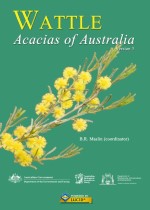 |
This WATTLE ver. 3 key (which is also available as an App) enables users to identify Wattles plants that occur anywhere in Australia or elsewhere in the world where they are grown. It includes over 1 000 formally described species of Acacia, plus several hybrids and informal taxa of this genus. It also includes two species of Acaciella, four species of Senegalia and nine species of Vachellia that occur in Australia and which were previously included in Acacia. WATTLE ver. 3 builds upon two previous versions of WATTLE, namely, the original version that was published in 2001 on CD and version 2 that was published in 2014 on the Lucidcentral website. Compared with earlier versions, which are no longer available, WATTLE ver. 3 contains more species, updated coding and new or updated descriptions for each taxon, together with photographs and improved distribution maps |
|
To use the WATTLE ver. 3 key click here and then click “Identify” For information on how best to use this key, and other information concerning WATTLE ver. 3, visit the LucidCentral website. |
|
The WATTLE App
The WATTLE App delivers the same WATTLE ver. 3 key, but packaged for use on an Android/Apple smartphone or tablet. No phone or Wi-Fi connection is required to use the key, making it especially valuable for people working in the field. More information on WATTLE App is available at the LucidCentral website.
The Android and Apple versions of the WATTLE App can be downloaded from the Google Play and iTunes app stores respectively on payment of $9.95 to help fund further content updates and software upgrades.
How to cite this work
Maslin, B.R. (coordinator) (2018). WATTLE: Interactive Identification of Australian Acacia. Version 3. (Australian Biological Resources Study, Canberra; Department of Biodiversity, Conservation and Attractions, Perth; Identic Pty. Ltd., Brisbane.)
Publication
WATTLE ver. 3 is jointly published by the Australian Biological Resources Study (ABRS), Canberra, The Western Australian Department of Biodiversity, Conservation and Attractions (formerly CALM) and Identic Pty Ltd, Queensland.
Acknowledgements
A project the size of WATTLE could not have been undertaken without the generous assistance and technical skills of many people over over many years. This help has been provided by many taxonomic and other specialists, artists, volunteers, government agencies (State, Territory and Commonwealth) and the private sector, and this assistance is gratefully acknowledged here.
For the initial (2001) version of WATTLE many people and institutions contributed and their efforts were grately appreciated. The 2014 revision (WATTLE ver. 2) was made possible by funding provided through Atlas of Living Australia. Rebecca Coppen is gratefully acknowledged for assistance with that update. For the current (2018) version (WATTLE ver. 3) we specifically acknowledge the following:
Images: For line drawings and photographs, the name(s) of people who created these images, together with an appropriate copyright statement, is associated with each image.
Descriptions: In a majority of cases the descriptions presented here are reformatted versions (updated where appropriate) of those published in the 2001 Flora of Australia treatment of Acacia (vols. 11A and 11B). New descriptions have been prepared for taxa described subsequent to publication of the Flora volumes. In all cases the contributing authors’ name(s) are shown at the bottom of each description.
Maps: Distribution maps were generated via Fact Sheet Fusion using the Atlas of Living Australia spatial portal web services. These maps were generated in July 2018. The data points include only those which were based on vouchered specimens extracted from the Australasian Virtual Herbarium (AVH), with records marked as cultivated being excluded. However some distribution anomalies may exist on the maps, for example, where cultivated specimens were not recorded as cultivated in the data records, or where data points were based on incorrectly identified specimens or where geocodes were incorrect.. To view the latest distribution records please visit the ALA or the AVH.